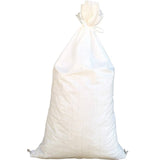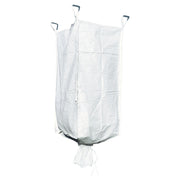The Perfect Sandbag for Large Sandbagging Machines
Preferred by most large scale sandbagging operations, these Sandbaggy Sandbags (NoTies) have no tie strings attached to the bag. Instead, they are meant to be sewn shut with a sewing machine for faster efficiency than tying the bags.
Why buy sandbags without ties?
- Increases production efficiency - If you are filling thousands of sandbags per day, tying sandbags is very slow and inefficient. Sewing the bags shut is much faster
- Saves Labor $ - Switching from tying sandbags to sewing them shut saves you thousands in labor costs over the long run!
Perfect For Building Water Barriers!
Get our best sandbags for flooding. Our 14" x 26" sandbags are built to take a beating and great for many uses, including sandbagging, water barriers, flood and erosion control, pipeline construction, and earthbag homes.
Our sandbags to prevent flooding are available in multiple colors: dark green, white, orange, beige, and black. The bags are constructed of a tough, woven polypropylene and are rigorously tested to ensure they can be filled with sand and dropped at least 10 times from 4 feet before showing any signs of wear. Get these sand bags for sale when you buy them in bulk!
Used To Prevent Flooding, Control Erosion, & More!
Learn more about our 14" x 26" Sandbags for flooding. These sandbags are heavy duty, reusable, and UV resistant, perfect for building sandbag water barriers. Watch our video below.
Specs
- Size: 14" x 26"
- Colors: Green OR Beige
- Material: Woven Polypropylene
- Weight Capacity: 50 lb
- Tie String Included: No, tie string is not included
Features
- WIDELY TRUSTED FOR FLOOD PROTECTION: Sandbaggy sandbags are used by many government agencies, landscapers/contractors, and nonprofits including the US Army and Red Cross. They are the #1 best selling sandbags on the Internet, with over 4 million Sandbaggy Sandbags installed across this great country. Whether for hurricanes on the East Coast or flooding in the Midwest, our flood protection sandbags have been there every step of the way as the first and last line of defense for the homes and businesses of everyday Americans.
- MILITARY GRADE: Used by the US Army, Sandbaggy sandbags are truly military grade (and military green too). With a double stitched bottom and a 50 lb weight capacity, these heavy duty Sandbags can be filled with sand or gravel. Our sandbags have a 14-inch wide opening, making them easy to fill and use.
- UV PROTECTION: Made with a UV Inhibitor that allows sandbag to last 6 months under direct sunlight in hot, sunny places such as California, Florida, and Arizona. In cooler regions of the country, our sandbags can last 6 to 24 months depending on the amount of sun exposure on a day to day basis.
- REUSABLE: Built from tough woven polypropylene, you can reuse these sandbags multiple times.
- EROSION CONTROL: Helps to prevent and minimize erosion on roads and beaches.
- CUSTOMERS LOVE THEM: Sandbaggy has been in business for more than 10 years. We're lucky to be able to serve such incredible customers every day to help protect their homes and businesses with sandbag walls, prevent erosion, and ensure temporary signs stay in place to keep drivers safe on the road.
- “These bags did the job perfectly!” - Allan L.
- “Bags were sturdy, very well made. Would def buy again.” - S. Hoffman.
- “Amazing sandbags. Ordered multiple times” - Christopher R.
Using Sand Bags For Flood Control
- Remove any debris from the areas where the sandbags will be placed
- Fill sandbags 1/2 to 2/3 full with your material (sand, dirt, mulch, gravel).
- Place sandbags outside and against the entry points of your home (such as doors and garages) to form a wall.
- Stack the bags like bricks, stacking the bag right in the middle of the 2 bags beneath it.
- Walk on the sandbags to create a tight seal between each bag.
Case Studies
See these Sandbags in action! Check out how our customers used these products.
How Sandbaggy Sandbags Protects Shoreline on Lake Michigan Property
Our sandbags are great for building a sandbag barrier to protect shorelines from erosion.
src="https://www.youtube.com/embed/AwO19nCWkTw" height="315" width="560" data-sanitized-allowfullscreen="" data-sanitized-allow="accelerometer; autoplay; clipboard-write; encrypted-media; gyroscope; picture-in-picture" data-sanitized-frameborder="0" data-mce-src="https://www.youtube.com/embed/AwO19nCWkTw">
How Sandbaggy Sandbags Protects Arizona Property
Build a sandbag barrier to protect your yard from flash floods. Our green sandbags also blend in great with the environment.
src="https://www.youtube.com/embed/UgBNRRIV_10" width="560" height="315" class="ui-droppable" data-sanitized-allow="accelerometer; autoplay; encrypted-media; gyroscope; picture-in-picture" data-sanitized-allowfullscreen="" data-sanitized-frameborder="0" data-mce-src="https://www.youtube.com/embed/UgBNRRIV_10">
Mississippi Customer Uses Sandbags to Build Waterfall & Koi Pond
Form a sandbag wall to create the framework for your outdoor projects. Sandbags provide a sturdy structure for many applications.

Hurricane and Storm Protection
Whether you need them for storms or hurricanes, Sandbaggy sandbags are used across the control to control and divert water. Learn more below.
Flood Barriers To Protect Your Property
When filled with sand, woven polypropylene sandbags stop flooding and water.
For the best results build a sandbag flood barrier. They are a fast and inexpensive solution to avoid damage to your property when there is a flood.
With polypropylene sandbags around your house, your house will be saved from flooding.
Since their invention, polypropylene sand bags have saved tens of thousands of homes from being flooded.
Tens of thousands of Sandbaggy empty sandbags for flood control were used to protect homeowners from flooding during Hurricane Florence in 2018.
Other names for Sandbags: Poly Bags, Sandbag, Sandbagging, Empty Sandbags, Sand bags, Military Sandbags, Polypropylene Bags, Sand bag
Comparing Different Size Sandbags For Flooding
| Size |
|  14" x 26" ultra heavy duty sandbags |  18" x 30" sandbags |  25" x 40" sandbags |  31" x 45" sandbags |  35"L x 35"W x 50"H bulk bags |  35"L x 35"W x 70"H 35"L x 35"W x 70"HFIBC Bulk Bags |  Ventilated Bulk Bags Ventilated Bulk Bags |  80" x 80" 80" x 80"poly sheets | |
| How to fill it |  Sandbag filler | |||||||||
| UV Protection | 3-6 months | 7-15 months | 6-9 months | 3-6 months | None | None | 1-6 months | 1-6 months | 1-6 months | None |
| Weight capacity | 50 lbs | 100 lbs | 90 lbs | 100 lbs | 100 lbs | 100 lbs | 2,000 lbs | 3,000 lbs | 2,200 lbs | N/A |
| What to put in it |
| sand |
|
|
|
|
|
|
| |
| Purpose |
|
|
|
| storage |
|
|
|
| collect green waste |
| Ties included | Yes | Yes | Yes | Yes | No | No | Yes (corner straps) | Yes (corner straps) | Yes (corner straps) | No |
| Color(s) |
| Black | White | White | White | White | White | White | White | White |
FAQ
What's the difference between monofilament bags, regular sandbags, and burlap bags?
They are all made from different materials. Monofilament bags are made from a heavier duty type plastic than regular sandbags, while burlap bags are made from jute, which is a plant fiber. Read more here.
Are sandbags effective against flooding?
Sandbags prevent flooding by acting as a water barrier to divert water, this is due to the sand's coarse texture making it less porous (ability to absorb water) than other materials. The main benefit of using sandbags to prevent flooding is just how simple and quick they are to use and set up.
What is the best material to put in a sandbag to block water?
The best material to put in a sandbag is sand or other material that can be tightly packed like dirt or mulch. Don't use things that have sharp edges like rocks, as that can damage the bag and are less effective at blocking water since it is not as dense as something like sand.
Where do you put sandbags for flooding?
To prevent flooding make sure to put sandbags outside and against the entry points of your home (such as doors and garages) to form a wall. Also identify other areas where you will need to divert water from.
How to fill sandbags for flooding
Fill sandbags 1/2 to 2/3 full with your material (sand, dirt, mulch, gravel). Then stack the bags like bricks, stacking the bag right in the middle of the 2 bags beneath it.

 12" x 38"
12" x 38"